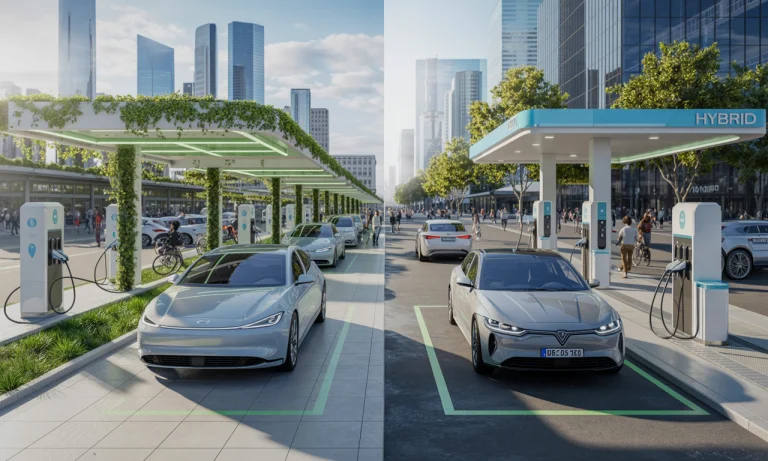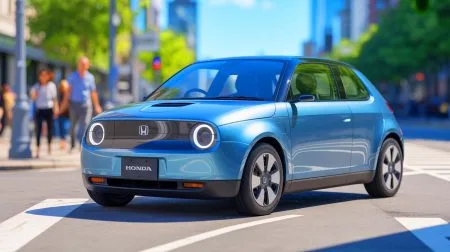Gasoline prices continue their upward climb, climate anxieties simmer in daily conversation, and parking lots from LA to Atlanta are now dotted with charging cables. For American drivers, the old binary of “fuel or no fuel” has collapsed under a wave of new choices, blending technology and necessity like never before. Should you go all-in on electric, or play it safe with a hybrid that straddles two worlds? Around kitchen tables and dealership lots, buyers discover that this is no longer a battle of gadgets—it’s about savings, convenience, and the steady march toward a future where every mile matters. Manufacturers from Tesla and Toyota to Hyundai, Kia, Chevrolet, Ford, Nissan, BMW, Honda, and Volkswagen have redrawn the landscape, making it both exciting and daunting to choose. This guide doesn’t just pit one against the other; it journeys through real American roads, costs, and routines, offering the keys to understanding which choice genuinely fits your life.
Comparing Hybrid Cars and Electric Vehicles: Pros, Cons, and Practical Realities
Picture Jamie, a Boston commuter reluctant to disrupt her routines. For her, hybrid vehicles deliver what feels like the best of both worlds—a gasoline engine for long hauls, an electric motor for short hops, and fuel economy that can outshine many traditional gas cars. The Toyota Prius, Honda Accord Hybrid, and Ford Escape Hybrid are staple names, but their true advantage lies in their flexibility. No need for at-home charging setups or cross-country route planning. The familiarity of fueling up at any corner station means you stay mobile, stress-free.
Yet, holding on to gasoline dependency comes at its own cost. In 2025, regular hybrids miss out on major federal and state incentives. While these cars excel in stop-and-go city scenarios, especially as shown by models from Kia and Hyundai, their dual systems can complicate maintenance compared to simpler gas or electric units. And though they often outpace their all-fossil-fuel counterparts in efficiency, hybrids still emit carbon—something a growing segment of buyers can’t easily accept.
| Hybrid Pros | Hybrid Cons |
|---|---|
| Independent of charging infrastructure | Not zero-emission; still uses gas |
| Lower upfront cost than most EVs | Complex mechanics increase maintenance |
| Strong city fuel economy | Limited federal/state credits in 2025 |
Electric Vehicles in Everyday U.S. Life: From Tesla to Chevrolet
Meanwhile, across town, Erin watches her Tesla Model 3 silently surge onto the freeway. Her daily commute is quiet, emissions-free, and her only stops are at home or one of the expanding network of chargers. For drivers ready to break up with gas stations, electric cars—whether it’s a Chevrolet Bolt, Nissan Leaf, Volkswagen ID.4, Ford F-150 Lightning, or the latest from Hyundai and BMW—offer a compelling proposition: low operating costs and a seat at the table of the future.
But, that path isn’t for everyone. Many U.S. regions—rural communities and areas far from big cities—still feel the strain of incomplete charging infrastructure. While the federal government races to install half a million chargers by decade’s end, some drivers rely on home setups to make EV ownership practical. Unquestionably, EVs boast fewer moving parts and require less routine maintenance, their prices are dropping, and in most states, savings ramp up every time the old pump is replaced by a wall plug. Yet, the range anxiety—persistent in much of the U.S.—is no myth.
| EV Advantages | EV Drawbacks |
|---|---|
| Zero tailpipe emissions | Public charging gaps remain in 2025 |
| Lower running and maintenance costs | Higher upfront prices (but falling) |
| Up to $7,500 federal credit (+local perks) | Need home charger for best convenience |
Total Cost of Ownership: Making Sense of Pricing, Savings, and Incentives
For first-time EV or hybrid buyers, the numbers matter just as much as the green credentials. The sticker shock of an EV—frequently $35,000 and up—is softened by the federal $7,500 tax credit and free municipal perks in states like California and New Jersey. Compare that to current mainstream hybrids, which often start around $25,000 and receive fewer (if any) financial nudges from Washington or local governments. Total cost of ownership, though, reveals the hidden layers: EVs generally cost less per mile and rack up savings on maintenance thanks to regenerative braking and fewer filters, fluids, and belts. In contrast, hybrids like those from Honda and Toyota require oil changes and more frequent visits for mechanical checks, but preserve flexibility for those driving long distances or living in regions where chargers remain rare.
| Category | Hybrid Vehicles | Electric Vehicles |
|---|---|---|
| Upfront price | $25,000–$35,000 | $35,000–$50,000 (before incentives) |
| Fuel/Electricity cost | 40–55 MPG, gas prices variable | $1.00–$1.50/“gallon” equivalent |
| Maintenance | Oil changes, traditional parts | Low/no oil changes, less wear |
| Tax incentives | Mostly plug-in hybrids only | Up to $7,500 federal, state/local perks |
| Best fit for | Flexible, long-distance drivers | Commuters, urban residents |
Charging Networks and Infrastructure: The Road to Nationwide Electrification
Anna’s cross-country trip from Houston to Salt Lake City offers a snapshot of infrastructure reality in America. With a Tesla, she rarely faces slowdowns thanks to the brand’s robust Supercharger network (a key part of Tesla’s dominance in the EV business), but driving a new Hyundai Ioniq 5 or BMW i4 reveals the patchwork of public chargers outside big cities is still a work in progress. Urban residents, especially in apartment complexes, sometimes find home charging out of reach, making a conventional hybrid or a plug-in hybrid (PHEV) from Kia or Ford the safer bet. The silver lining? Federal investment in charging points is accelerating faster than expectations, and new houses increasingly come wired for Level 2 charging, hinting at the moment when home charging becomes the norm for most Americans. But, for now, choice of vehicle still closely mirrors where and how you live.
EV and Hybrid Tax Credits in the U.S.—What’s Actually Available Now?
Sophia and her partner, each working in different parts of Seattle, realized that not all “clean cars” come with the same government perks. While plug-in hybrids and full EVs often unlock thousands in credits and rebates, regular hybrids like the classic Toyota Prius are largely excluded from new federal incentives. Local programs, though, create a patchwork of extra perks: reduced registration fees, toll breaks, and access to carpool lanes make EVs and some plug-ins attractive in metros from New York to Denver. Buyers are wise to research: battery capacity, place of assembly, and personal income can all affect which cars earn the coveted $7,500 break or qualify for used-EV credits up to $4,000. The result? Choosing the right car often comes down to more than environmental ideals—it pays to understand the ever-evolving incentive map.
Which Vehicle Suits Your Everyday Life: Urban, Rural, or Something in Between?
The real question for 2025 isn’t just what you drive—it’s how, and why. Parker, living in a Boston condo, swapped his gasoline sedan for a Nissan Leaf, relishing plug-and-play charging and zero tailpipe emissions. Carla, based in rural Nebraska and clocking 300 miles a day, trusts a Ford hybrid for both savings and freedom from charger searches. Meanwhile, green-minded professionals in cities from Austin to San Francisco flock to EVs, knowing they have access to both infrastructure and renewable electricity. Each story, from first-time buyers to seasoned car owners, is shaped by a few core questions: Do you have a garage? Are your drives short or epic? Is your state offering juicy rebates? Those factors—not just brand or trend—shape the smart choice for years ahead.
Key Questions Before Buying: FAQs for 2025
What are the biggest daily differences between driving a hybrid and an EV?
Hybrid drivers enjoy seamless refueling and longer range, while EV owners often appreciate the convenience of home charging and quieter, quicker acceleration. Infrastructure and personal commute habits remain decisive.
How quickly is the EV charging network improving?
Investment is accelerating, with tens of thousands of new stations expected by 2030. Tesla, Volkswagen, and Ford lead efforts, but coverage still varies widely, especially outside metro areas.
Will hybrids continue to receive incentives in the future?
Conventional hybrids rarely qualify for federal credits as of 2025. Only plug-in hybrids (PHEVs) with substantial battery range see significant incentives.
How does resale value compare between hybrids and EVs?
Brands like Tesla and Toyota tend to retain strong resale value, especially when models are well maintained. Regular maintenance and mileage have less impact on EVs due to reduced mechanical complexity. See more on this resale value guide.
Can I save on maintenance if I choose electric?
Yes. EVs lack engines, exhausts, and many serviceable parts found in hybrids and gas cars, translating to lower routine costs. Still, battery replacement and tire care remain important—tips found here: save money on car repair.
For a deep dive into fuel-efficient models, EV adoption strategies, and test driving insights, explore:
Best Fuel Efficient Cars |
Latest 2025 Electric Cars |
Test Driving Tips.
Did you like it? 4.3/5 (24)







